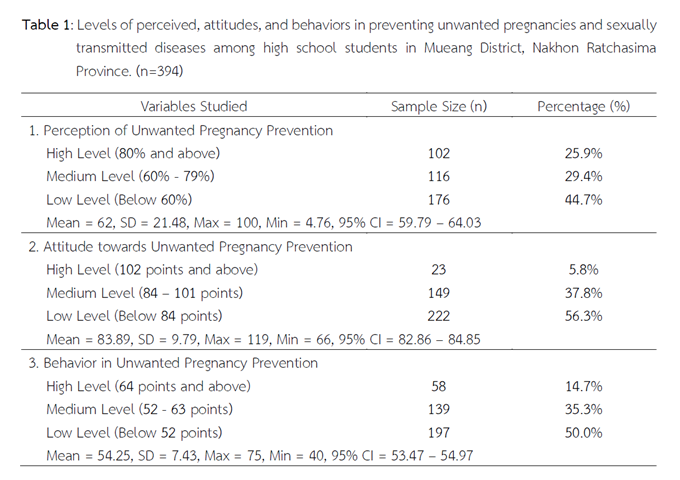ปัจจัยที่มีความสัมพันธ์ต่อพฤติกรรมการป้องกันการตั้งครรภ์ไม่พึงประสงค์และโรคติดต่อทางเพศสัมพันธ์ของนักเรียนมัธยมศึกษา อำเภอเมือง จังหวัดนครราชสีมา
คำสำคัญ:
การตั้งครรภ์ไม่พึงประสงค์, โรคติดต่อทางเพศสัมพันธ์, นักเรียนมัธยมศึกษาบทคัดย่อ
การวิจัยเชิงพรรณนาภาคตัดขวางนี้มีวัตถุประสงค์ เพื่อศึกษาปัจจัยที่มีความสัมพันธ์ต่อพฤติกรรมการป้องกันการตั้งครรภ์ไม่พึงประสงค์และโรคติดต่อทางเพศสัมพันธ์ของนักเรียนมัธยมศึกษา อำเภอเมือง จังหวัดนครราชสีมา กลุ่มตัวอย่างเป็นนักเรียนมัธยมศึกษา จำนวน 394 คน อายุระหว่าง 12-18 ปี เก็บรวบรวมข้อมูลโดยใช้แบบสอบถาม ผ่านการตรวจสอบคุณภาพโดยการวิเคราะห์ค่าดัชนีความสอดคล้องระหว่างข้อคำถามกับเนื้อหา มีค่าเท่ากับ 0.89 และการวิเคราะห์ความเชื่อมั่นตัวแปรการรับรู้ฯ ด้วยวิธี KR-20 มีค่าเท่ากับ 0.96 และหาค่าสัมประสิทธิ์แอลฟ่าของครอนบาค ตัวแปรด้านเจตคติฯ และพฤติกรรมฯ เท่ากับ 0.79 และ 0.64 ตามลำดับ วิเคราะห์ข้อมูลด้วยสถิติเชิงพรรณนา ได้แก่ ร้อยละ ค่าเฉลี่ย ส่วนเบี่ยงเบนมาตราฐาน และสถิติอนุมาน ได้แก่ การทดสอบไคสแควร์ ผลการศึกษาพบว่า ปัจจัยที่มีความสัมพันธ์กับพฤติกรรมในการป้องกันการตั้งครรภ์ไม่พึงประสงค์และโรคติดต่อทางเพศสัมพันธ์ ได้แก่ เพศ ผลการเรียน และอาชีพหลักของผู้ปกครอง อย่างมีนัยสำคัญทางสถิติ (p< .05) ส่วนปัจจัยด้านการรับรู้ฯ ไม่มีความสัมพันธ์กับพฤติกรรมการป้องกันการตั้งครรภ์ไม่พึงประสงค์และโรคติดต่อทางเพศสัมพันธ์ โดยสรุป เพศ ผลการเรียน อาชีพหลักผู้ปกครอง และเจตคติฯ มีความสำคัญต่อการวางแผนและกำหนดแนว เพื่อการปรับเปลี่ยนพฤติกรรมการป้องกันการตั้งครรภ์ไม่พึงประสงค์และโรคติดต่อทางเพศสัมพันธ์ของนักเรียน
เอกสารอ้างอิง
Best, J.W. (1977). Research in Education (3rd ed). Engelwood Cliffs, New Jersy: Pretice Hall, Inc.
Bloom, B.S. (1968). Taxonomy of education objective: Handbook 1: Cognitive domain. New York: David MCI.
Bureau of AIDS Tuberculosis and sexually transmitted diseases. (2020). National Strategic Plan on Ending the AIDS problem 2017-2030. Department of Disease Control. https://ddc.moph.go.th/das/
Chan-Ame, S. (1988). Child psychiatry (4th ed). Bangkok: Thai Wattana Publishing.
Division of AIDS and Sexually Transmitted Diseases, Department of Disease Control. (2020). Status of the HIV epidemic in Thailand in 2020. https://ddc.moph.go.th/das/index.php
Division of Innovation and Research, Ministry of Public Health. (2019). Situation of sexually transmitted diseases in Thailand. https://ddc.moph.go.th/dir/index.php
Duvall, E. M. (1977). Marriage and family development (5th ed.). Philadelphia: Lippincott.
Office of Disease Prevention and Control 9 Nakhon Ratchasima. (2022). Achievements of patient service regarding sexually transmitted diseases for the year 2022. http://odpc9.ddc.moph.go.th/post/65-report.pdf
Rojruangnon P. et al. (2016). Factors Related to Preventive Behaviors of Unexpected Pregnancy among the Female Undergraduates, Bangkok Metropolitan. J Sci Technol MSU, 36(2). 194-202.
Sabaiying, M. (2019). Sexual Risk Behavior among High School Students in Current Society. Academic Services Journal, Prince of Songkla University, 30(3), 121-127.
Santrock, J.W. (2001). Adolescence. Bonston: Mc Graw-Hill.
Sirited et al. (2017). Effects of the life skills development program on self-efficacy in preventing teenage pregnancy of Female secondary school students, Phra Nakhon Si Ayutthaya Province. Thai Journal of Public Health, 47(3), 241-254.
Sirited et al., (2020). Knowledge of sexually transmitted diseases and attitude about sexually transmitted diseases prevention according to Communicable Disease Act, B.E. 2558 among secondary school students in Mueang District, Phetchaburi Province. Public Health Policy and Laws Journal, 6(Supplement), S53-S70.
Sittipiyasakul V. et al. (2013). A Survey on Sexual Experiences, Opinions and Sexual Risk Behaviors among Teenage Students in Thailand. Journal of Health Science, 22(6), 979-987.
Sribenchamas N. et al. (2023, March 15). Factors affecting to behaviors preventing unwanted pregnancy of female senior high school student, Muang district, Phitsanulok province [Paper presentation]. The 3rd Kamphaeng Phet Rajabhat University Student National Conference, Kamphaeng Phet, Thailand.
The Secondary Educational Service Area Office Nakhon Ratchasima. (2021). Action plan for fiscal year 2022. https://spmkorat.go.th
Thepkhayan, P. (2021). Perceptions, Understanding, and Behavior of NIDA Staff Toward the Policy on Operational Excellence. Bangkok: Office of the President National Institute of Development Administration.
Wattanayingcharoenchai S. (2019). Thai people's health report 2019. Department of Disease Control. Bangkok. https://www.hfocus.org
WHO. (2011). Health and Health System Responsiveness Survey. http://www.who.int/responsiveness/en/
WHO. (2019). Unsafe Abortion-Global and Regional Estimates of the Incidence of Unsafe Abortion and Associated Mortality. https://www.who.int/publications/i/item/9789241501118
Wong-arsa W. et al. (2015). Factors Affecting Sexual Risk Behaviors Among Adolescents: a Case Study Conducted in One University. Journal of Public Health, 45(3), 285-297.
Yamane, T. (1967). Statistics, An Introductory Analysis (2nd ed.). New York: Haper and Row.

ดาวน์โหลด
เผยแพร่แล้ว
วิธีการอ้างอิง
ฉบับ
บท
การอนุญาต
ลิขสิทธิ์ (c) 2024 วารสารสาธารณสุขมูลฐาน (ภาคตะวันออกเฉียงเหนือ)

This work is licensed under a Creative Commons Attribution-NonCommercial-NoDerivatives 4.0 International License.



